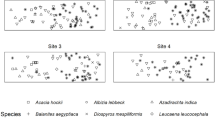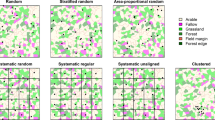Abstract
Agroforestry systems have been recognized as areas with high conservation potential, and there is a need to quickly assess the biodiversity and tree stocking density available in these systems. However, it is not clear if the commonly used fixed area plot is most efficient for sampling such landscapes, or if a different method could provide equivalent data with less effort. Thus, a field and simulation-based study was carried out to compare the efficiency and accuracy of a variable area transect versus the fixed area square plot. Field efficiency tests were carried out in three habitat types, robusta coffee plantations, arabica coffee plantations and a privately owned forest fragment, in Kodagu, southern India. A simulation study of bias, precision and accuracy of the two methods for tree density estimation also was carried out using various spatial distribution patterns and densities. The variable area transect was significantly more efficient per unit effort in the field than the fixed area square plot. In the simulation tests both methods performed equally well under random spatial distribution. However, under simulated aggregated distribution both methods were positively biased (square plot up to 12% at low density, variable area transect 9–12% at all densities), and under simulated regular distribution the variable area transect was slightly negatively biased (−5 to −7% at medium to high density). The variable area transect thus can be recommended over the square plot for rapid assessment of tree diversity and density, when the vegetation is expected to be randomly dispersed.


Similar content being viewed by others
References
Armesto JJ, Mitchell JD, Villagran C (1986) A comparison of spatial patterns in some tropical and temperate forests. Biotropica 18:1–11
Barbour MG, Burk JH, Pitts WD (1987) Terrestrial plant ecology, 2nd edn. Benjamin/Cummings, Menlo Park
Batcheler CL, Craib DG (1985) A variable area plot method of assessment of forest condition and trend. NZ J Ecol 8:83–95
Bhagwat SA, Kushalappa CG, Williams PH, Brown ND (2005) A landscape approach to biodiversity conservation of sacred groves in the Western Ghats of India. Conserv Biol 19:1853–1862
Bormann FH (1953) The statistical efficiency of sample plot size and shape in forest ecology. Ecology 34:474–487
Bryant DM, Ducey MJ, Innes JC et al (2004) Forest community analysis and the point-centered quarter method. Plant Ecol 175:193–203
Champely S (2007) pwr: Basic functions for power analysis. R package version 1.1
Clapham AR (1932) The form of the observational unit in quantitative ecology. J Ecol 20:192–197
Clark PJ, Evans FC (1954) Distance to nearest neighbor as a measure of spatial relationships in populations. Ecology 35:45–453
Condit R, Ashton PS, Baker B et al (2000) Spatial patterns in the distribution of tropical tree species. Science 288:1414–1418
Cottam G, Curtis JT (1956) The use of distance measures in phytosociological sampling. Ecology 37:451–460
Crawley MJ (2007) The R book. Wiley, New York
Di Stefano J (2004) A confidence interval approach to data analysis. For Ecol Manag 187:173–183
Elouard C (2000) Vegetation features in relation to biogeography. In: Ramakrishnan PS, Chandrashekara UM, Elouard C et al (eds) Mountain biodiversity, land use dynamics, and traditional ecological knowledge. Oxford/IBH, New Delhi, pp 25–42
Elouard C, Chaumette M, de Pommery H (2000) The role of coffee plantations in biodiversity conservation. In: Ramakrishnan PS, Chandrashekara UM, Elouard C et al (eds) Mountain biodiversity, land use dynamics, and traditional ecological knowledge. Oxford/IBH, New Delhi, pp 120–144
Engeman RM, Sugihara RT, Pank LF, Dusenberry WE (1994) A comparison of plotless density estimators using Monte Carlo simulation. Ecology 75:1769–1779
Garcia CA, Bhagwat SA, Ghazoul J et al (in press) Biodiversity conservation in agricultural landscapes: challenges and opportunities of coffee agroforestry in the Western Ghats, India. Conserv Biol
Gerard PD, Smith DR, Weerakkody G (1998) Limits of retrospective power analysis. J Wildl Manag 62:801–807
Gimaret-Carpentier C, Pélissier R, Pascal J-P, Houllier F (1998) Sampling strategies for the assessment of tree species diversity. J Veg Sci 9:161–172
Good RE, Good NF (1971) Vegetation of a Minnesota prairie and a comparison of methods. Am Midl Nat 85:228–231
Grafen A, Hails R (2002) Modern statistics for the life sciences. Oxford University Press, Oxford
Hubbell SP (1979) Tree dispersion, abundance, and diversity in a tropical dry forest. Science 203:1299–1309
Kenkel NC, Podani J (1991) Plot size and estimation efficiency in plant community studies. J Veg Sci 2:539–544
Laycock WA, Batcheler CL (1975) Comparison of distance-measurement techniques for sampling tussock grassland species in New Zealand. J Range Manag 28:235–239
Lindsey AA, Barton JD Jr, Miles SR (1958) Field efficiencies of forest sampling methods. Ecology 39:428–444
Lyon LJ (1968) An evaluation of density sampling methods in a shrub community. J Range Manag 21:16–20
Mark AF, Esler AE (1970) An assessment of the point-centred quarter method of plotless sampling in some New Zealand forests. Proc NZ Ecol Soc 17:106–110
McNeeley JA, Schroth G (2006) Agroforestry and biodiversity conservation—traditional practices, present dynamics, and lessons for the future. Biodivers Conserv 15:549–554
Moppert B (2000) Expansion of coffee plantations and landscape changes. In: Ramakrishnan PS, Chandrashekara UM, Elouard C et al (eds) Mountain biodiversity, land use dynamics, and traditional ecological knowledge. Oxford/IBH, New Delhi, pp 88–98
Parker KR (1979) Density estimation by variable area transect. J Wildl Manag 43:484–492
Pascal J-P (1988) Wet evergreen forests of the Western Ghats of India; ecology, structure, floristic composition and succession. Institut Français de Pondicherry, Pondicherry
Perfecto I, Rice RA, Greenberg R, van der Voort ME (1996) Shade coffee: a disappearing refuge for biodiversity. Bioscience 46:598–608
Pinheiro JC, Bates DM (2000) Mixed-effects models in S and S-PLUS. Springer, New York
Pinheiro J, Bates D, DebRoy S et al (2008) nlme: Linear and nonlinear mixed effects models. R package version 3.1-89
R Development Core Team (2008) R: a language and environment for statistical computing. R Foundation for Statistical Computing, Vienna, Austria. ISBN: 3-900051-07-0. http://www.R-project.org
Risser PG, Zedler PH (1968) An evaluation of the grassland quarter method. Ecology 49:1006–1009
Scott CT, Gove JH (2002) Forest inventory. In: El-Shaarawi AH, Piegorsch WW (eds) Encyclopedia of environmetrics. Wiley, Chichester, pp 814–820
Sheil D, Puri RD, Basuki I et al (2002) Exploring biological diversity, environment and local people’s perspectives in forest landscapes. Methods for a multidisciplinary landscape assessment. Center for International Forestry Research, Bogor
Sheil D, Ducey MJ, Sidiyasa K, Samsoedin I (2003) A new type of sample unit for the efficient assessment of diverse tree communities in complex forest landscapes. J Trop For Sci 15:117–135
Sokal RR, Rohlf FJ (1995) Biometry: the principles and practice of statistics in biological research, 3rd edn. W. H. Freeman and Co, New York
Steidl RJ, Hayes JP, Schauber E (1997) Statistical power analysis in wildlife research. J Wildl Manag 61:270–279
Thomas L (1997) Retrospective power analysis. Conserv Biol 11:276–280
Thomas L, Juanes F (1996) The importance of statistical power analysis: an example from animal behaviour. Anim Behav 52:56–859
Walther BA, Moore JL (2005) The concepts of bias, precision and accuracy, and their use in testing the performance of species richness estimators, with a literature review of estimator performance. Ecography 28:815–829
White NA, Engeman RM, Sugihara RT, Krupa HW (2008) A comparison of plotless density estimators using Monte Carlo simulation on totally enumerated field data sets. BMC Ecol 8:6
Acknowledgements
Funding was provided by the CAFNET project of the EuropAid program of the European Union (Connecting, enhancing and sustaining environmental services and market values of coffee agroforestry in Central America, East Africa and India, CAFNET—Europaid/ENV/2006/114-382/TPS). We are grateful to the farmers and estate managers who permitted us to use their properties for data collection. We thank N. Barathan for his assistance with species identification and specimen collection, S. Aravajy for species confirmation, and the technicians, students and field assistants of the French Institute of Pondicherry and Forestry College, Ponnampet, Kodagu, for assistance in the field. We also thank Douglas Sheil for helpful discussions during fieldwork and critical comments on the manuscript, and two anonymous reviewers for their valuable comments.
Author information
Authors and Affiliations
Corresponding author
Rights and permissions
About this article
Cite this article
Nath, C.D., Pélissier, R. & Garcia, C. Comparative efficiency and accuracy of variable area transects versus square plots for sampling tree diversity and density. Agroforest Syst 79, 223–236 (2010). https://doi.org/10.1007/s10457-009-9255-5
Received:
Accepted:
Published:
Issue Date:
DOI: https://doi.org/10.1007/s10457-009-9255-5




